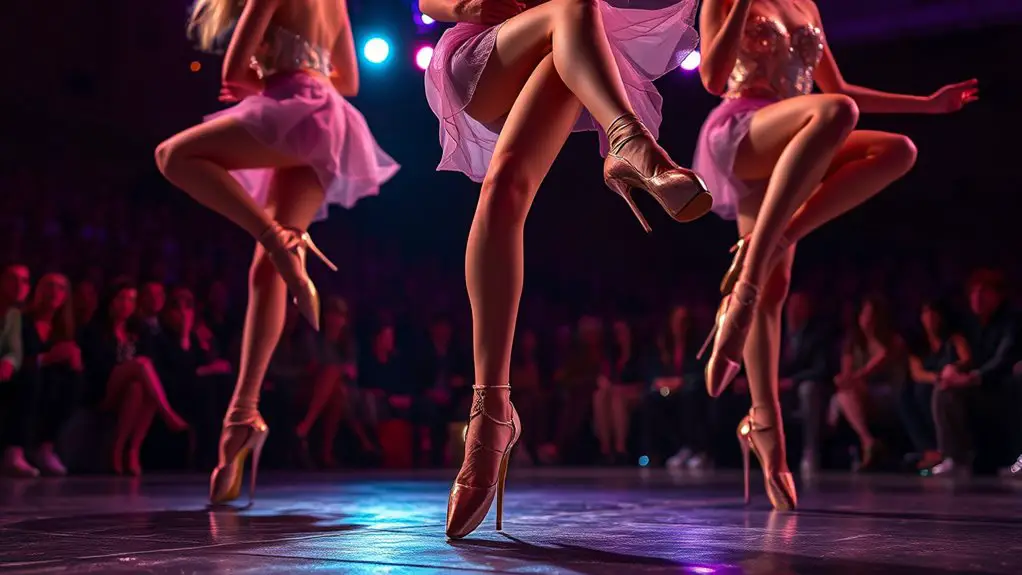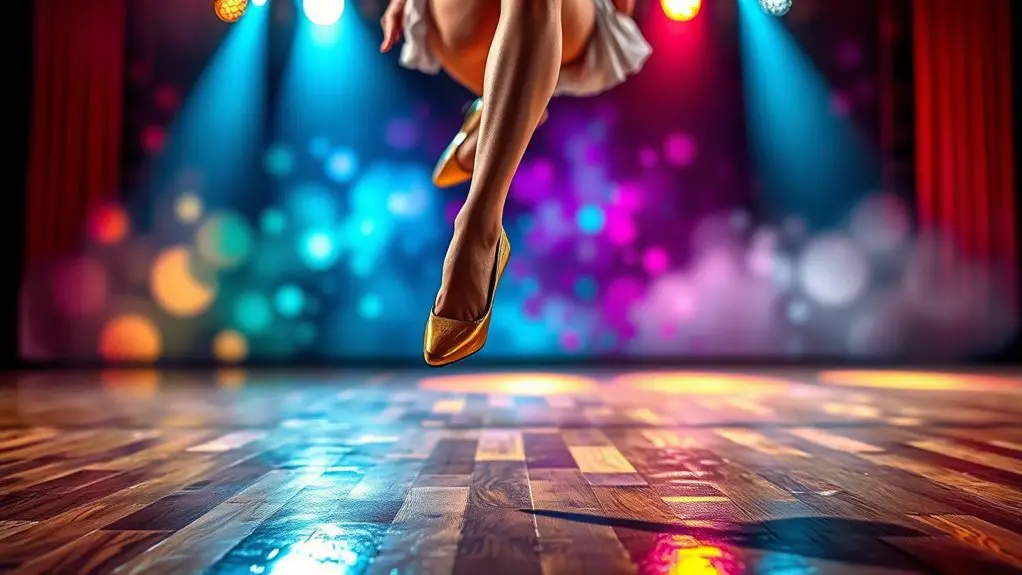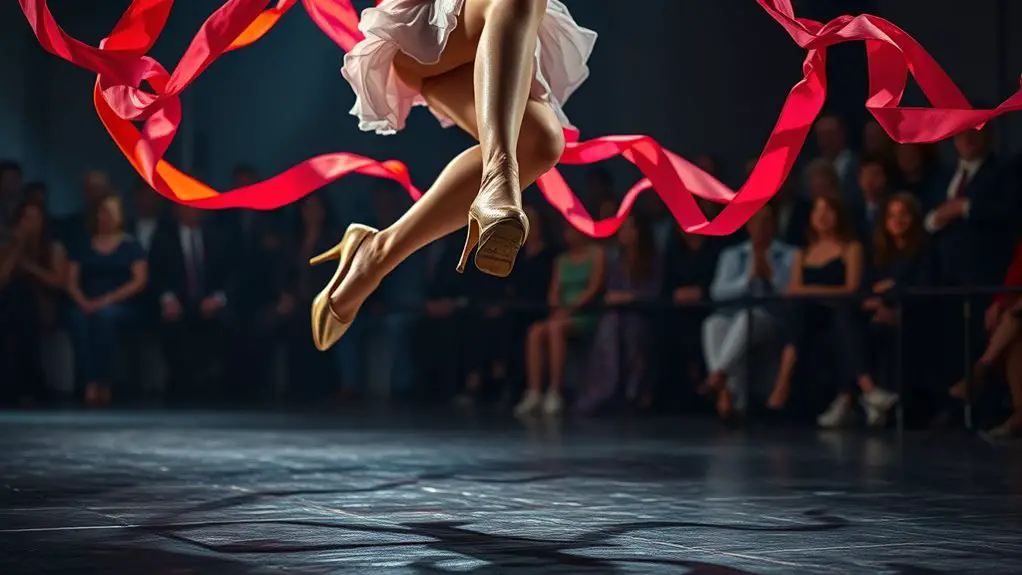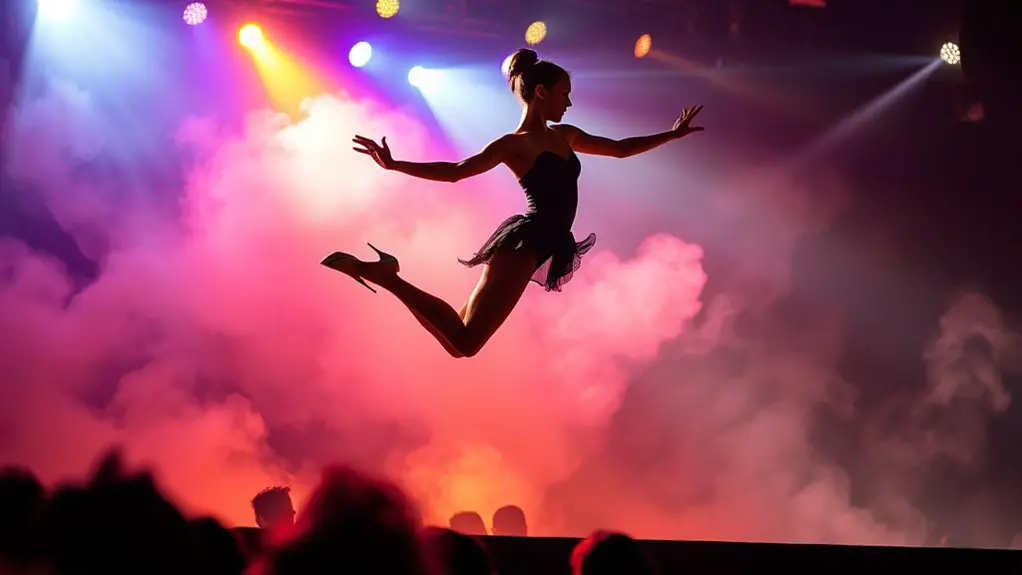Dancing in high heels is thrilling yet perilous, pushing your skills and balance to the limit. Routines, like Beyoncé’s in “Single Ladies” or Janet Jackson’s in “Rhythm Nation,” showcase intricate movements that demand precision while teetering on stiletto heels, amplifying the risk of injury. The elevated center of gravity complicates performances, making every step a test of strength and control. Discovering the dynamics of such high-heel routines reveals much about artistry and the challenges dancers face in their craft.
The Rise of High Heels in Dance

As dance evolves, high heels have increasingly become a signature element, enchanting audiences with their striking combination of elegance and danger. This shift marks a significant chapter in fashion evolution, where the fusion of style and movement creates a mesmerizing spectacle. Historically, high heels began as a symbol of aristocracy, but over time, they’ve transcended social barriers to find their place on dance floors.
You’ll notice how these shoes alter posture, accentuating the dancer’s silhouette and enhancing their grace. The inherent challenge of balancing on stilettos adds a thrilling dimension to performances, pushing the boundaries of skill and artistry. Dance history reflects this evolution, showcasing how heels have transformed from mere fashion statements to essential tools for expression. As you watch, consider how these dynamic elements intertwine, transforming each routine into a breathtaking display of power and poise, all while maneuvering the delicate line between beauty and risk.
Iconic High Heel Dance Performances
While high heels can be a source of both allure and peril, they have undeniably shaped some of the most memorable dance performances in history. The combination of style and skill in high-heel choreography creates an experience that captivates audiences. Here are four iconic performances that showcase the power of dancing in heels:
- Beyoncé in “Single Ladies” – The sharp, synchronized movements paired with her stiletto heels redefined pop dance.
- Lady Gaga in “Bad Romance” – Her unique footwork in towering heels contributed to the song’s edgy, theatrical vibe.
- Janet Jackson in “Rhythm Nation” – The precision and strength displayed while dancing in heels emphasized her groundbreaking choreography.
- Madonna in “Vogue” – The elegance and fluidity of her moves in heels created an unforgettable visual impact.
These performances not only highlight technical prowess but also the cultural significance of high-heel dance routines.
The Challenges of Dancing in Heels

Dancing in heels presents a unique set of challenges that can test even the most skilled performers. The need for heel stability becomes paramount as you navigate intricate routines. Each step requires precise control, and any miscalculation can lead to an ungraceful stumble. The elevation of heels changes your center of gravity, introducing balance challenges that can complicate even simple movements.
You might find that your ankles bear the brunt of this added strain; they must work harder to keep you upright. This demands not just physical strength but also a heightened awareness of your body’s positioning. As you dance, the constant adjustment to maintain balance can be mentally taxing. Each twist and turn becomes a delicate dance with gravity, where confidence is as vital as technique. Embracing these challenges can transform your performance, pushing you to new heights—literally and figuratively.
Safety Precautions for Dancers
To guarantee a safe and enjoyable experience on the dance floor, dancers must prioritize their safety precautions, especially when performing in high heels. High heels can amplify the risk of injuries, making injury prevention essential. Here are some key safety measures to take into account for effective performance:
- Choose Proper Footwear: Select heels that offer support and cushioning. Avoid excessively high or narrow styles that compromise stability.
- Warm-Up: Engage in a thorough warm-up to prepare your muscles and joints for the demands of dancing.
- Practice Balance: Regularly practice balancing exercises to enhance stability and strengthen your ankles, reducing the risk of falls.
- Know Your Space: Be aware of your surroundings and avoid crowded spaces to minimize the chance of collisions.
Notable Dancers Who Mastered High Heels

Many dancers have pushed the boundaries of performance by mastering the art of dancing in high heels, showcasing both skill and creativity. Among these legendary performers, you’ll find names like Beyoncé and Lady Gaga, whose heel choreography captivates audiences worldwide. Their routines blend intricate footwork with powerful stage presence, transforming traditional dance into a breathtaking spectacle.
In addition, dancers like Janet Jackson and the iconic Josephine Baker have paved the way for high-heel artistry, combining sensuality and athleticism. Their ability to maintain balance and execute complex moves while wearing heels not only demonstrates technical prowess but also redefines femininity in dance.
These performers challenge the norms, proving that high heels can elevate a dance routine to extraordinary heights. By studying their innovative approaches, you gain insight into the precision and creativity necessary to master this daring form of expression.
The Impact of High Heels on Dance Techniques
While high heels can enhance the visual appeal of a performance, they also considerably alter dance techniques. The elevated heel height affects your foot alignment, demanding an adjustment in your posture and balance. You might find yourself developing new skills to accommodate these changes, including:
- Weight Distribution: You’ll need to learn how to shift your weight effectively to maintain stability on the heels.
- Core Engagement: A strong core becomes essential for balance, as it stabilizes your movements and supports your heel height.
- Ankle Flexibility: Increased ankle strength and flexibility are vital to execute moves without risking injury.
- Artistic Expression: High heels can enhance your performance’s allure, but they require precision in every step to convey the intended emotion.
Ultimately, dancing in heels transforms not just the aesthetic, but also the very mechanics of your dance technique.
Future Trends in High Heel Dance Routines
As the dance world evolves, high heel routines are poised to embrace innovative trends that blend creativity with practicality. You’ll likely see a surge in future choreography that emphasizes a balance between artistic expression and dancer safety. Choreographers are experimenting with heel innovation, incorporating features like shock-absorbing materials and adjustable heights to enhance performance. This evolution will empower dancers to explore more complex movements without compromising their safety.
Moreover, the integration of technology is set to play a pivotal role. Wearable tech could monitor balance and posture, offering real-time feedback for improvement. Expect to see hybrid styles emerge, merging traditional dance forms with street and contemporary influences, all while maintaining the allure of high heels. Ultimately, these trends will redefine the boundaries of high heel dance routines, making them not only visually stunning but also more accessible and safer for dancers of all levels.
Frequently Asked Questions
What Types of High Heels Are Best for Dancing?
When choosing high heels for dancing, prioritize stability features and moderate heel height. Look for wider bases and ankle support to guarantee balance, allowing you to move confidently while minimizing the risk of injury.
How Do High Heels Affect Foot Health Over Time?
Wearing high heels is like walking a tightrope; it’s thrilling yet precarious. Over time, they can strain your foot arch and lead to issues, especially with excessive heel height, impacting overall foot health greatly.
What Are the Most Common Injuries From Dancing in Heels?
When dancing in heels, you’re likely to experience ankle sprains and toe injuries. The height and structure of the shoes can strain your joints, leading to instability and increased risk of painful, long-lasting damage.
Are There Specific Dance Styles That Should Avoid High Heels?
You should definitely avoid high heels in contemporary styles, as they emphasize fluid movements. However, ballroom dancing can accommodate heels, provided you choose stable designs that support your technique without compromising your safety or grace.
How Can Beginners Learn to Dance in High Heels Safely?
To learn to dance in high heels safely, focus on heel safety by practicing beginner techniques like proper posture, balance exercises, and starting with lower heels. Gradually increase height as your confidence and skill develop.


